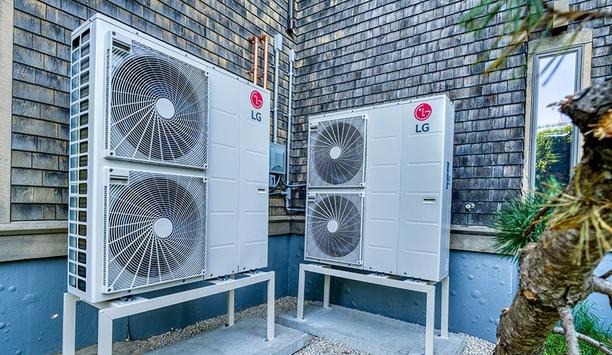Kensa Group - Experts & Thought Leaders
Latest Kensa Group news & announcements
Residents in 74 homes are having their lives changed and bills reduced thanks to ground source heat pumps (GSHP) in Appledore and Charing. The £2.2m scheme is the first time that Ashford Borough Council has installed GSHP heating systems in its residential properties. Energy-saving measures The scheme is part of a bigger drive by the council to retrofit around 700 homes with energy-saving measures using Government funding of £5.1m. The money – from the Social Housing Decarbonization Fund Wave 2 – is bolstered by a £6.2m contribution from the council. Working with a delivery partner, improvements already delivered over the past 18 months include cavity wall insulation, external wall insulation, new windows and doors, underfloor insulation, air source heat pumps, and solar panels. How the GSHP systems work Working with a delivery partner, improvements have already been delivered over the past 18 months Cllr Noel Ovenden, Council Pioneer and Portfolio Holder for Housing, said: “These measures will cut carbon emissions, help reduce energy demand and give residents more money in their pockets from cheaper energy bills." "We’re working closely with our tenants to ensure they understand how the GSHP systems work and to recognize the tremendous benefits they will enjoy because of these exciting improvements." Heat pump technology Ovenden added: “Embracing ground source heat pump technology is an exciting first for Ashford Borough Council and I’m confident it will transform tenants’ lives by boosting energy security, saving money and providing a warmer and more comfortable home for them to enjoy." “In addition to these life-changing benefits for tenants, the upgrades to our most energy-inefficient rural homes will help the council with our ambition to become a carbon-neutral borough by 2030.” Low-carbon heating Cabinet member for Climate Change, Cllr Steve Campkin, said: “We’ve been working hard to reduce carbon emissions in a way that benefits people in very real ways, and the most direct way is low carbon heating in properly insulated homes." "The move towards renewables and a carbon-free society has benefits above and beyond carbon reduction and makes sense regardless of climate change. I’m very excited about this project.” Electric and gas heating systems Work on installing the hi-tec systems involves drilling multiple bore holes to depths of about 100 meters Work on installing the hi-tec systems involves drilling multiple bore holes to depths of around 100 meters. The council is working with British GSHP specialist Kensa to deliver the project, which is due to be completed this summer. This is the first scheme that the council has worked on with Kensa, which has installed ground source heat pumps in thousands of council homes in the UK. The ground source heat pumps are being fitted at homes in Heathside and Hawthorn in Appledore and Clearmount Drive in Charing, replacing a mix of oil-fired, electric, and gas heating systems. Drilling bore holes 100m deep: how the technology works Ground source heat pumps are an effective, highly efficient, low-carbon heating system that harnesses natural, freely available heat stored in the ground. The heat pump collects this low-grade heat and boosts it to a higher temperature to provide the home with low-cost heating and hot water whenever the resident needs it. For this project, multiple boreholes are being drilled deep underground and fitted with a network of pipes. A mixture of water and antifreeze circulates within these pipes, absorbing the natural heat from the earth. Traditional central heating system Kensa Shoebox heat pumps being installed are compact enough to fit inside each property This mix is then passed through the heat pump, which compresses and enhances this energy so it can heat the water used in the home’s radiators and hot water systems. The Kensa Shoebox heat pumps being installed are compact enough to fit inside each property and provide the home with heat via radiators as part of a traditional central heating system. Energy-efficient and sustainable heating options Stuart Gadsden, Commercial Director at Kensa, said: “We’re excited to collaborate with Ashford on this brilliant project, helping to decarbonize their properties while providing residents with a reliable, highly efficient low-carbon heating solution." “Our ground source heat pumps are among the most energy-efficient and sustainable heating options available and, depending on the system they replace, residents could benefit from significantly lower energy bills and a heavily reduced carbon footprint." "We have a proven track record of installing our British-made heat pumps in thousands of social homes and are looking forward to extending these benefits to even more residents through this initiative with Ashford.” Ground source heat pumps Our residents in Heathside in Appledore said: “I think this is a great idea. Our electric storage heaters are expensive to run and I’m looking forward to saving the pennies and have a warmer, more comfortable home,” Craig Godden. “I had no hesitation in signing up for it. My house is due to done in June and I can’t wait,” Julie Gill. “Storage heaters are costing me a fortune so this is a very good idea. My daughter is jealous that I’m getting ground source heat pumps fitted,” Peter Simpson. Working with the tenants Ashford Borough Council and Kensa are working closely with tenants in Appledore and Charing to ensure they are kept fully informed about the works.
Pupils and teachers at Marshland Primary Academy in Moorends, near Doncaster, part of Venn Academy Trust, are celebrating cutting their carbon footprint after successfully installing a modern ground source heat pump system and other state-of-the-art energy efficiency measures. Working with Kensa, the UK’s pioneer manufacturer and installer of ground source heat pumps, the school is trailblazing how to go green, overhauling its old heating and hot water system and replacing the aging gas boilers with seven new ground source heat pumps. Renewable heating installations The six-month project, partially funded by the Government’s Condition Improvement Fund, also included fitting new radiators and 69 solar PVT panels, an emerging technology used in renewable heating installations. The upgrades are expected to boost the school’s energy efficiency, cut heating-related carbon emissions by close to 80%, and ensure classrooms stay warm and comfortable throughout the year for the benefit of staff and pupils alike. To reach the underground energy, 18 boreholes were drilled beneath the school’s playing field The newly installed ground source heat pumps use renewable energy stored in the earth to provide heating and hot water and are hidden inside two converted plant rooms. To reach the underground energy, 18 boreholes were drilled beneath the school’s playing field, each to a depth of around 127m. Ground source heat pump installation Solar PVT has been integrated into the school’s ground source heating system, taking it beyond a standard ground source heat pump installation. The technology generates both electricity and thermal energy, supercharging the heat pump’s efficiency and lowering installation and energy costs. This integration works by: Thermal heat energy captured by the PVT panels is removed and transferred to the heat pump system, improving its efficiency and reducing electricity use. Using this excess thermal energy in the heat pump system significantly reduces the number of boreholes needed, lowering the overall installation costs. Extracting the excess thermal heat from the panels increases the amount of electricity they can produce compared to ordinary solar PV panels. It's projected they will generate 34 kW of electricity—the output of 10 typical homes with solar panels. Marshland Primary Academy is one of the first UK schools to embrace this energy-saving technology alongside a heat pump installation. Renewable heating system To meet the government’s goals of reducing public sector carbon emissions by 75% by 2037 Investing in energy efficiency upgrades has provided the school with a low-cost, low-maintenance, renewable heating system, securing its energy future while providing long-term savings on heating and hot water bills. To meet the government’s goals of reducing public sector carbon emissions by 75% by 2037, thousands of schools across the UK will need to follow Marshland Primary’s example, replacing their ageing, high-carbon-emitting heating systems and embracing more innovative, modern technologies. This latest school ground source heat pump installation follows more than fifteen others Kensa has completed in schools, including in South Wales and Northumberland, along with another in Doncaster at Richmond Hill Primary School. Carbon-emitting heating systems Penny Marshall, Acting Principal at Marshland Primary Academy, said: “It has been an exciting journey watching and learning about the innovative ground source heating. Although the children had to sacrifice their field for the summer, they enjoyed watching the holes being bored and learning from Kensa staff how the system worked.” “Energy efficiency and helping the environment is a big focus at Marshland, so it is exciting to be able to know that we are playing a small part in a much bigger picture by using natural resources to heat our school. This winter has been a toasty one at Marshland!” Efficient heating system Wouter Thijssen, Commercial Director at Kensa, said: "We’re proud to have worked with Marshland Primary Academy to deliver a more sustainable and efficient heating system. Thanks to a mix of super-efficient ground source heat pumps and other energy efficiency upgrades, pupils and teachers will enjoy warm classrooms while slashing their carbon footprint.” “By opting for ground source heat pumps, boosted by solar PVT, the school has secured its long-term energy future, setting the benchmark for achieving sustainability in UK schools. Kensa’s mission is to deliver better heating, and this installation certainly lives up to that promise.”
A groundbreaking project that brought low-carbon, low-cost heating to one of London’s oldest social housing estates has been named Regional Large-Scale Project of the Year at the 2025 Greater London Energy Efficiency Awards. Sutton Dwellings, a historic Edwardian-era social housing estate in Kensington, received the prestigious award for the innovative approach taken by leading ground source heat pump specialists Kensa and housing provider Clarion Housing Group in retrofitting 81 flats at the central London location. Transition to low-carbon heating The task acts as a blueprint for social housing decarbonization, proving that even aging Each flat has undergone a significant transformation, receiving extensive energy efficiency upgrades and a modern networked ground source heat pump system. The project serves as a blueprint for social housing decarbonization, proving that even aging, ‘complex to decarbonize’ buildings can successfully transition to low-carbon heating. Kensa’s Shoebox heat pumps At the heart of the project is a networked heat pump system, which saw Kensa’s Shoebox heat pumps discreetly fitted inside every flat and connected to a network of 27 boreholes drilled across the dense, urban estate. This system provides each home with a long-term renewable heat source, delivering low-cost heating and hot water while preserving the estate's historic character. improving energy efficiency in social housing The project’s recognition comes as councils and social housing providers start to receive £1.29 billion The project’s recognition comes as councils and social housing providers start to receive £1.29 billion in funding from the Warm Homes: Social Housing Fund, a government-backed initiative aimed at improving energy efficiency in social housing. With the fund set to support upgrades across the UK, the Sutton Dwellings project provides a proven model for decarbonizing flats and older buildings, while ensuring resident energy bills remain affordable. Critical role of networked heat pumps For many social housing residents, rising energy costs are an ongoing concern. At Sutton Dwellings, the new system is expected to reduce heating bills to as little as £300 per year for a one-bedroom flat, demonstrating the huge cost-saving potential that comes with fitting ground source heat pumps and improving energy efficiencies. The UK’s aging housing stock presents a major challenge to achieving net zero, but Sutton Dwellings is proof that solutions already exist – and work. The project builds on Kensa’s extensive experience in decarbonizing thousands of UK social homes and highlights the critical role of networked heat pumps in the transition to clean, affordable heating at scale. Modern heating technology New system is expected to reduce heating bills to as little as £300 per year for a one-bedroom flat Stuart Gadsden, Commercial Director for Social Housing at Kensa, said: "Winning this award is a fantastic recognition of the innovation and commitment that made this project a success and is a testament to the work Clarion has done to deliver quality homes for their residents while also cutting their carbon emissions." “This project is proof that no home should be left behind in the transition to low-carbon heating. Any building can embrace modern heating technology, including ground source heat pumps, and social housing residents deserve homes that are warm, comfortable and future-proofed against rising energy costs.” Power of collaboration and innovation David Hunter, Director of Housing at Clarion Housing Group, said: "At Clarion, we are committed to ensuring our homes are not only fit for the future but also remain affordable and comfortable for our residents today." "Retrofitting historic estates like Sutton Dwellings with cutting-edge, energy-efficient solutions proves that every type of home can be decarbonized. This award is a testament to the power of collaboration and innovation in making social housing more sustainable while helping residents lower their energy costs."
Insights & Opinions from thought leaders at Kensa Group
Decarbonizing heat is one of, if not the biggest challenges we face in our journey to net zero. Most of the heat in UK homes and businesses is currently provided through fossil fuels, predominantly gas. Gas releases carbon emissions and other particles that are bad for air quality and bad for our environment. So, to get to net-zero we need to replace gas as our main source of heat. The Government plans to phase out gas boilers in newly build homes from 2025, but with the vast majority of existing homes reliant on gas as the energy source to heat their homes, many householders fear a ‘gas boiler ban’ without a realistic and reliable alternative. This needs to be addressed. The challenge These grants will only cover a fraction of the 600,000 per year installation target set for 2028 To nudge the change in consumer purchasing behavior, a £5,000 grant was announced by the government in its heat and buildings strategy as part of a £450m Boiler Upgrade Scheme to install low-carbon systems. But many commentators have pointed out that these grants will only cover a fraction of the 600,000 per year installation target set for 2028. Both the Climate Change Committee and the UK Government have said that to reach net-zero we should be aiming to install 600,000 heat pumps per year by 2028. That’s a big scaling up of the existing market, as to date between 30,000 to 40,000 pumps are installed each year. Heat pump technology Heat pumps have been highlighted by the government in their recent Heat and Buildings Strategy as a key solution to decarbonizing our economy. That is why, Kensa Group, Britain’s ground source heat pump experts, recognize the need to make sure people understand clearly how heat pumps work and how they can provide the comfort of current heating systems but operate more efficiently over their lifetime. There are two types of heat pumps - air source and ground source, the latter of which use pipes to extract heat and waste heat from the ground to heat radiators, underfloor heating systems, cool and provide hot water. Ground source heat pumps provide the lowest capital cost heat decarbonization pathway with reduced running costs, reduced electrical generation and storage requirements, and importantly carbon savings. Emissions from gas boilers A ground source heat pump can be 300-400% efficient, delivering three to four times the amount of energy Typical emissions from a gas boiler are 226g/kWh – this equates to up to 2.7 tonnes per year for an average house – the equivalent of driving 12,000 miles in an average family car. The emissions level of a ground source heat pump is 53g/kWh. Similarly, modern gas boilers can be around 90% efficient – a ground source heat pump can be 300-400% efficient, delivering three to four times the amount of energy they consume from electricity. The pipework of underground infrastructure will last upwards of 100 years so a one-off investment will provide heat for generations to come. Yet the true benefits that heat pumps can bring won’t ever make the impact needed unless they are introduced at scale. Moving to heat pumps One option includes a solution that takes responsibility away from individuals to change their boilers to one that introduces a large-scale network of ground source heat pumps similar to the design and infrastructure of the current gas grid. It’s a bold idea but one that manufacturers, the government, and the energy sector are exploring with one study predicting a move to networked heat pumps could save the UK an estimated £1bn a year to 2050. The infrastructure By shifting the emphasis from consumers getting rid of their boilers and installing individual infrastructure for ground source heat pumps on an ad-hoc house-by-house basis, a move to a pre-installation of utility-scale underground infrastructure (how the gas grid works today), it’s believed the 600,000 annual heat pump target could be met. With the infrastructure funded, owned, and maintained by a utility supplier or local authority, for example, the cost is removed from consumers who can then easily and cheaply change to a heat pump as and when they’re ready and pay a standing charge similar to what they do for their existing gas supply. Accelerate net-zero ambitions Kensa Heat Pumps is giving people the chance to see first-hand how alternative heating could work This approach has the promise to be a mass-market and mass scale solution which if adopted, could transform our low carbon landscape and accelerate net-zero ambitions. The challenge is how we make this a reality at scale because we need action to start soon, as time continues to run away from us. Using the latest augmented reality technology, Kensa Heat Pumps is giving people the chance to see first-hand how this alternative heating could work in communities like theirs, as an entire street has been stripped of boilers and switched to heat pumps in a virtual makeover. Bringing the future of heating to life Using the real-life inner-city suburb of Green Street in Glasgow as a basis for the AR experience, Kensa’s virtual tour guide Doug sets out just how the ground source heat pumps and network can heat entire streets from houses to tower blocks, in a ground-breaking concept called ‘Welcome to Green Street’. The virtual street map ‘Welcome to Green Street’, launched at COP26, proves how a whole systems approach to decarbonizing how we heat our homes can unlock benefits across communities, and complement and balance the electricity network as we come to rely more heavily on it with heating and electric vehicles.
From A To L: Your A2L Transition Guide
DownloadLeveraging Radiant And Hydronics To Help Achieve Decarbonization Goals
DownloadSealed Connectors In Harsh Environments
DownloadPowering And Cooling Next Generation Data Centers
DownloadDebunking Myths To Promote A Bright Future For Heat Pumps
Download

























